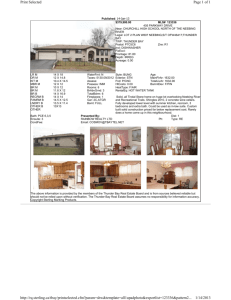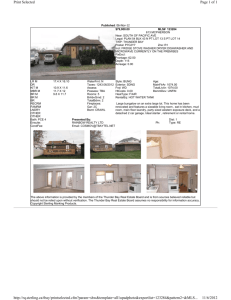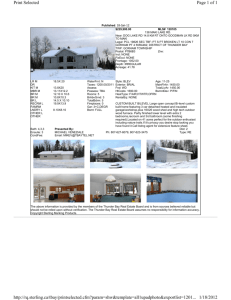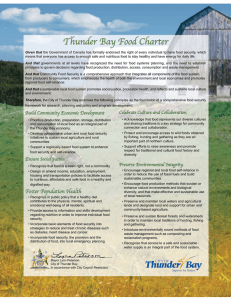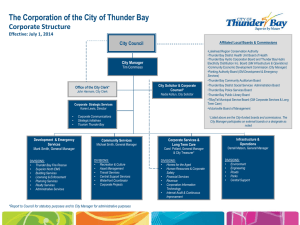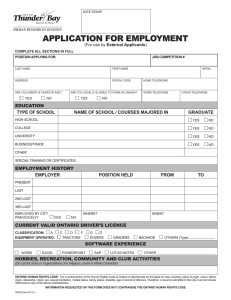Thunder Bay AREA OF CONCERN
advertisement
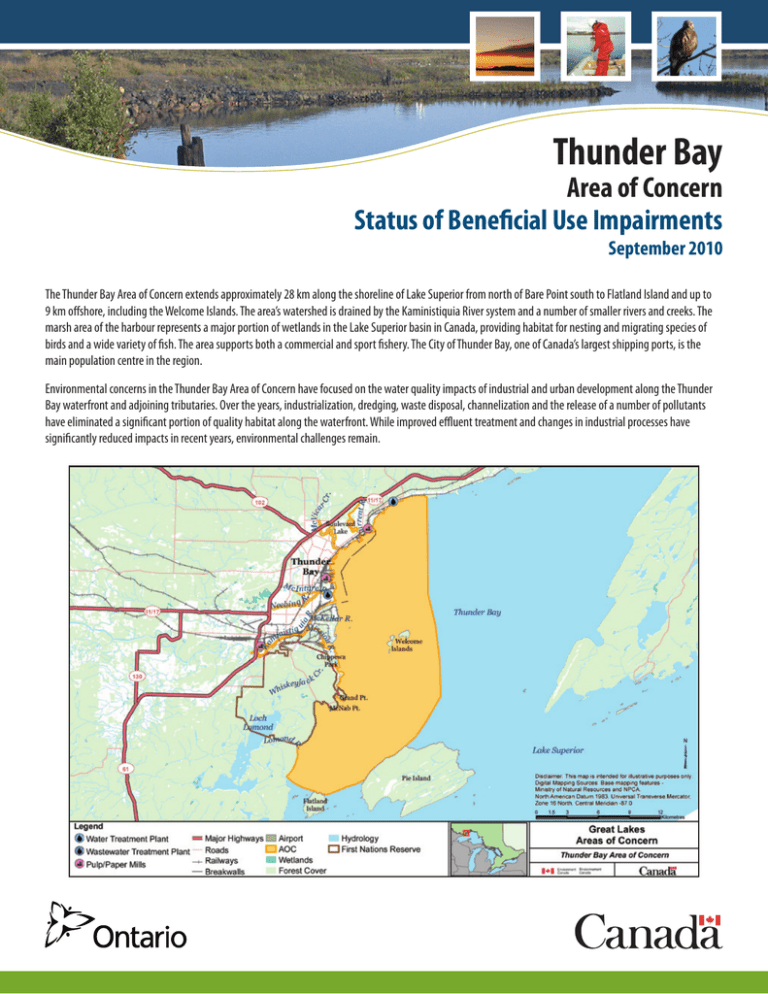
Thunder Bay Area of Concern Status of Beneficial Use Impairments September 2010 The Thunder Bay Area of Concern extends approximately 28 km along the shoreline of Lake Superior from north of Bare Point south to Flatland Island and up to 9 km offshore, including the Welcome Islands. The area’s watershed is drained by the Kaministiquia River system and a number of smaller rivers and creeks. The marsh area of the harbour represents a major portion of wetlands in the Lake Superior basin in Canada, providing habitat for nesting and migrating species of birds and a wide variety of fish. The area supports both a commercial and sport fishery. The City of Thunder Bay, one of Canada’s largest shipping ports, is the main population centre in the region. Environmental concerns in the Thunder Bay Area of Concern have focused on the water quality impacts of industrial and urban development along the Thunder Bay waterfront and adjoining tributaries. Over the years, industrialization, dredging, waste disposal, channelization and the release of a number of pollutants have eliminated a significant portion of quality habitat along the waterfront. While improved effluent treatment and changes in industrial processes have significantly reduced impacts in recent years, environmental challenges remain. PARTNERSHIPS IN ENVIRONMENTAL PROTECTION Thunder Bay was designated an Area of Concern in 1987 under the Canada–United States Great Lakes Water Quality Agreement. Areas of Concern are sites on the Great Lakes system where environmental quality is significantly degraded and beneficial uses are impaired. Currently, there are 9 such designated areas on the Canadian side of the Great Lakes, 25 in the United States, and 5 that are shared by both countries. In each Area of Concern, government, community and industry partners are undertaking a coordinated effort to restore environmental quality and beneficial uses through a remedial action plan. Remedial Action Plan Partners Environment Canada and the Ontario Ministry of the Environment coordinate the development and implementation of the remedial action plans to protect and restore these Areas of Concern in Canada. Other partners in the cooperative effort in the Thunder Bay Area of Concern include (in alphabetical order) the City of Thunder Bay, Confederation College, EcoSuperior Environmental Programs, Fisheries and Oceans Canada, the Lakehead Region Conservation Authority, Lakehead University, the Ontario Ministry of Natural Resources, the Public Advisory Committee and the Thunder Bay District Health Unit. Remedial Action Plan Process The Great Lakes Water Quality Agreement requires that remedial action plans be developed and implemented in three stages: Stage 1: Identifying the Environmental Challenges In Stage, 1 the governments of Canada and Ontario, working with community stakeholders, undertook an extensive program of research and monitoring to assess environmental quality and identify the causes of degradation in the Area of Concern. The Stage 1 Remedial Action Plan Report, summarizing the outcome of these efforts, was completed in 1991. The report identified 11 environmental challenges needing to be addressed and known as beneficial use impairments in the Remedial Action Plan process. Stage 2: Planning and Implementing Remedial Actions In Stage 2, the governments of Canada and Ontario, working with community stakeholders, undertook a detailed review of several potential remedial actions to restore, protect and monitor environmental quality in the Area of Concern. The Stage 2 Remedial Action Plan Report, which identified 38 recommended remedial actions, was completed in 2004. Of the original 11 beneficial use impairments, one was addressed by the time Stage 2 was completed (added costs to agriculture and industry). Most of the recommended remedial actions have been completed or are in progress. The current status of the remaining 10 beneficial use impairments is described below in Progress on Environmental Challenges. Stage 3: Monitoring Actions and Delisting of the Area of Concern The Stage 3 Remedial Action Plan Report and delisting of Thunder Bay as an Area of Concern will take place when monitoring confirms that the beneficial use impairments have been addressed successfully through the remedial actions. The management of contaminated sediment in the north harbour will take several more years to address. Consequently, as of September 2010, it is difficult to estimate when Thunder Bay will be delisted as an Area of Concern. 2 Thunder Bay AREA OF CONCERN PROGRESS ON ENVIRONMENTAL CHALLENGES The federal and provincial governments and partners have made significant progress in addressing the beneficial use impairments identified through the Remedial Action Plan process. In addition to the specific actions summarized in the tables below, the partners have carried out several important actions that have addressed more than one environmental challenge. Notable successes have included upgrading the main wastewater treatment plant to secondary treatment with UV disinfection, which has significantly improved the quality of effluent entering the lake. The Thunder Bay District Stewardship Council was established to bring together interested landowners, individuals, associations, municipalities, First Nations and resource agencies on such stewardship projects as natural resource education, shoreline restoration and wildlife habitat enhancement. Another major cross-cutting initiative has been the management of contaminated sediment adjacent to the Northern Wood Preservers waterfront industrial property through the Northern Wood Preservers Alternative Remediation Concept (NOWPARC) project. This project involved constructing a rock fill containment berm, a steel wall and clay barrier to isolate the contaminants; removing contaminated sediment by dredging and thermal treatment off-site; and creating 5 ha of fish habitat. In a collaborative effort with the local industry partners, the Ontario Ministry of the Environment and Environment Canada began the assessment of management options for the contaminated sediment in the Thunder Bay north harbour in 2008. The project steering committee will continue to provide updates to the Public Advisory Committee. Remedial Action Plan partners will continue working together on the following priority initiatives in support of delisting the Thunder Bay Area of Concern: managing contaminated sediment in Thunder Bay north harbour; reviewing and revising appropriate targets for restoring the beneficial use impairments; developing and implementing a monitoring plan to track progress towards environmental recovery and meeting delisting targets; and providing opportunities for community engagement on the remedial actions and monitoring activities. Status of Beneficial Use Impairments The tables below summarize, for each of the 10 beneficial use impairments in the Thunder Bay Area of Concern, their status as of September 2010; key actions taken by various partner agencies and organizations under the Remedial Action Plan; and future key actions planned by the partners as they work towards the full restoration of environmental quality and eventual delisting of the Area of Concern. Status – IMPAIRED Degradation of Aesthetics Status: Impaired Aesthetics are degraded as a result of the presence of industrial development and closed and abandoned facilities along the waterfront. KEY ACTIONS COMPLETED Completed sediment remediation at NOWPARC, including construction of a natural buffer along the waterfront Achieved changes in industrial processes and upgrades to wastewater treatment facilities at area pulp and paper mills, following the provincial Municipal/Industrial Strategy for Abatement regulations (1993) and federal pulp and paper regulations (1992) Demolished the former Pool 6 elevator Completed Kaministiquia River Heritage Park Completed improvements at the Mission Marsh Conservation Area, including creation of small bays for fish habitat Launched community programs such as Spring Up to Clean Up and Litter Free Thunder Bay REMAINING Complete additional improvements in Marina Park and continue community cleanup initiatives Identify options for the redevelopment of the former Pool 6 site Complete public consultation to confirm targets for addressing this beneficial use impairment 3 Degradation of Benthos1 Status: Impaired Recent and future monitoring will track recovery of the benthic community below the AbitibiBowater outfall in the Kaministiquia River and near the NOWPARC site. In the north harbour the benthic community remains impaired due to contaminated sediment. KEY ACTIONS COMPLETED REMAINING Implemented federal pulp and paper regulations and the provincial Municipal/ Industrial Strategy for Abatement (MISA) regulations in the mid-1990s, which led to process changes and upgrades to wastewater treatment at area pulp and paper mills Completed sediment remediation at NOWPARC and began ongoing monitoring Completed upgrades to the municipal sewage treatment plan Undertook study (field component) of sediment quality, water quality and benthic communities in the Kaministiquia River (2005) Commenced assessment of sediment management options for the contaminated sediments in the Thunder Bay north harbour Identify and evaluate sediment management options and implement the preferred option for the Thunder Bay north harbour Continue long-term monitoring at the affected sites Complete reporting for the Kaministiquia River study Degradation of Fish and Wildlife Populations Status: Impaired Impairment of fish populations has been identified as a result of degraded water quality, increased water temperatures, industrial pollutants, land use development and the introduction of aquatic invasive species. KEY ACTIONS REMAINING Implemented federal pulp and paper regulations and the provincial Municipal/ Industrial Strategy for Abatement (MISA) regulations in the mid-1990s, which led to process changes and upgrades to wastewater treatment at area pulp and paper mills Assessed the fish community around areas of remediation at the NOWPARC site, concluding that the area now supports good diversity and abundance of fish populations comparable to other areas within the harbour Developed binational rehabilitation plans for four fish species native to Lake Superior—Brook Trout, Walleye, Lake Sturgeon and Lake Trout—with the overall goal of maintaining, enhancing and rehabilitating self-sustaining populations in areas where the species were originally found Promoted the recovery of Lake Trout in Lake Superior through cooperative efforts involving stocking programs, Sea Lamprey control measures, limits on sport and commercial fishing, and water quality protection and enhancements Mapped critical habitat for Lake Sturgeon in the Kaministiquia River and examined the effects of changing water levels and flows on Sturgeon production Developed and implemented a water management plan (in cooperation with Ontario Power Generation) to address water level fluctuations in the Kaministiquia River and the effect on Lake Sturgeon populations Commenced assessment of sediment management options for the contaminated sediments in the Thunder Bay north harbour Identify and evaluate sediment management options and implement the preferred option for the Thunder Bay north harbour Complete analysis of data collected on fish and wildlife and conduct additional population surveys to assess current status of this environmental challenge Continue long-term monitoring at the NOWPARC and other created habitat sites to determine impacts of remedial actions on fish populations Benthos and benthic community refer to the invertebrate organisms, such as worms, nymphs and insect larvae that dwell for all or part of their lives in the bottom sediments of lakes and rivers. Scientists often use the health and abundance of these organisms as indicators of contaminant toxicity and ecosystem health. 1 4 COMPLETED Thunder Bay AREA OF CONCERN Loss of Fish and Wildlife Habitat Status: Impaired Degradation of wetlands and spawning and nursery habitat has been identified as one of the causes resulting in the reduction of Walleye and Lake Sturgeon populations. KEY ACTIONS COMPLETED REMAINING Undertook various habitat rehabilitation projects to restore and create nearshore aquatic habitat in five tributaries, rehabilitate the littoral zone, stabilize wetlands, improve diversity in rivers, and increase abundance of fish populations Confirmed that the Kaministiquia River and Neebing, McKellar and Mission marshes provide nursery habitat for young Walleye Examine the effects of changing water levels and flows on Sturgeon access to spawning habitat in the Kaministiquia River Monitor the fish community at rehabilitation sites in the Area of Concern, including NOWPARC, to determine whether additional changes or improvements to the fish community have occurred since the mid-1990s Restrictions on Dredging Activities Status: Impaired Dredging of sediment from the inner harbour is restricted due to elevated levels of contaminants. Periodic dredging for navigational purposes will continue; this must be done in compliance with existing requirements to determine appropriate disposal plan in accordance with current regulations. KEY ACTIONS COMPLETED REMAINING Implemented federal pulp and paper regulations and the provincial Municipal/ Industrial Strategy for Abatement (MISA) regulations in the mid-1990s, which led to process changes and upgrades to wastewater treatment at area pulp and paper mills Completed sediment remediation at NOWPARC Commenced assessment of sediment management options for the contaminated sediments in the Thunder Bay north harbour Identify and evaluate sediment management options and implement the preferred option for the Thunder Bay north harbour Status – REQUIRES FURTHER ASSESSMENT Beach Closings Status: Requires further assessment While considerable improvements have been undertaken at Chippewa Park, the overall status of this beneficial use impairment remains inconclusive for swimming areas at Chippewa Park and Boulevard Lake. KEY ACTIONS COMPLETED Improved natural flow in the Current River and Boulevard Lake through removal of an old dam on Onion Lake Completed beach remediation at Chippewa Park, involving the installation of culverts in the breakwall and improved site drainage REMAINING Conduct DNA analysis on samples from both sites to identify the sources of bacteria and develop recommendations based on these results Complete review of targets for restoring this beneficial use impairment 5 Bird (or Other Animal) Deformities or Reproduction Problems Status: Requires further assessment Bird and animal deformities have not been reported within the boundaries of the Area of Concern. However, deformities in Cormorants have occurred at nearby colonies at Cone and Gravel Islands. In the period of 1988–1994 the incidence of deformities was the lowest in the Great Lakes at 1.2 per 10 000; it was still elevated compared to areas outside of the Great Lakes. KEY ACTIONS COMPLETED REMAINING A Canadian Wildlife Service survey on the Great Lakes (1973–1991) indicated that during that time period Cormorant populations were reproducing at normal levels and that the number of colonies on Lake Superior had increased In the summer of 2000, the CWS resurveyed Complete assessment of this environmental challenge to determine status Degradation of Phytoplankton and Zooplankton2 Populations Status: Requires further assessment This beneficial use was assumed to be impaired in the Stage 2 Report, but was not assessed prior to that determination. Results from a 2005 study are still pending. KEY ACTIONS COMPLETED Achieved changes in industrial processes and upgrades to wastewater treatment facilities at area pulp and paper mills, following the provincial Municipal/Industrial Strategy for Abatement (1993) regulations and federal pulp and paper regulations (1992) Undertook a study of total phosphorous and chlorophyll (2005) 2 6 REMAINING Complete assessment of this environmental challenge to determine status, following analysis of 2005 study Phytoplankton and zooplankton are the collection of small or microscopic water-borne plant and animal organisms (respectively) that float or drift in great numbers, especially at or near the water’s surface, and that serve as food for fish and other larger organisms. Thunder Bay AREA OF CONCERN Fish Tumours or Other Deformities Status: Requires further assessment The incidence of liver tumours in White Suckers sampled in Thunder Bay declined more than 5% between 1985–1990 and 2006. This analysis confirmed that the incidence of tumours in Thunder Bay White Suckers is similar to reference sites. However, the fish collected in Thunder Bay were on average 5 years younger than fish from the reference location. KEY ACTIONS COMPLETED REMAINING Implemented federal pulp and paper regulations and the provincial Municipal/ Industrial Strategy for Abatement (MISA) regulations in the mid-1990s, which led to process changes and upgrades to wastewater treatment at area pulp and paper mills Completed sediment remediation at NOWPARC and began ongoing monitoring Undertook 2006 study of fish tumours with detailed comparison to other sites in the Great Lakes An additional survey emphasizing older fish would add certainty to the decision on the status of this beneficial use. If the results of the additional fish survey indicate a tumour prevalence of less than 5%, then this beneficial use will be considered restored Restrictions on Fish and Wildlife Consumption3 Status: Requires further assessment Restricted consumption of Lake Trout, Walleye, Whitefish and other species is advised due to elevated levels of contaminants such as mercury, PCBs,3 dioxins, furans, chlorinated phenols and pesticides. It is not clear whether sources within the AOC are contributing to this advisory. KEY ACTIONS COMPLETED REMAINING Implemented federal pulp and paper regulations and the provincial Municipal/ Industrial Strategy for Abatement (MISA) regulations in the mid-1990s, which led to process changes and upgrades to wastewater treatment at area pulp and paper mills Completed remediation at NOWPARC Began ongoing monitoring at NOWPARC, including assessing sediment and water quality, and benthic and fish communities to measure changes in the area following remediation (2009) Diverted mercury from area landfills Collected sport fish in Thunder Bay inner harbour for contaminant assessment (2005 and 2006) Commenced assessment of sediment management options for the contaminated sediments in the Thunder Bay north harbour Continue monitoring of sport fish and long-term monitoring at the NOWPARC site and compare with fish resident outside the AOC Polychlorinated biphenyls (PCBs) are synthetic chemicals that have wide industrial applications. The manufacturing and importing of PCBs were banned in North America in 1977. PCBs are very persistent (long-lasting) in the environment and can be transported over long distances. 3 7 Thunder Bay AREA OF CONCERN FOR MORE INFORMATION Environment Canada: www.ec.gc.ca/raps-pas North Shore of Lake Superior Remedial Action Plans: www.northshorerap.ca ISBN: 978-1-100-18077-9 Cat. No.: En164-22/15-2011E-PDF PIBS: 8232e Published by Environment Canada and the Ontario Ministry of the Environment For information regarding reproduction rights, please contact Public Works and Government Services Canada at 613-996-6886 or at droitdauteur.copyright@tpsgc-pwgsc.gc.ca Photos and map: © Ontario Ministry of the Environment, Environment Canada © Her Majesty the Queen in Right of Canada, represented by the Minister of the Environment, 2011 © Queen’s Printer for Ontario, 2011 Aussi disponible en français
